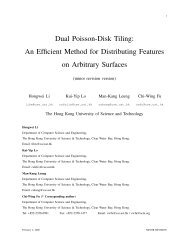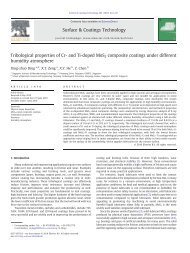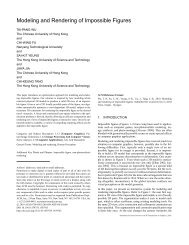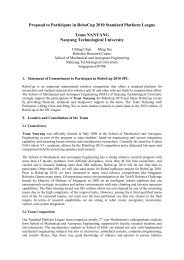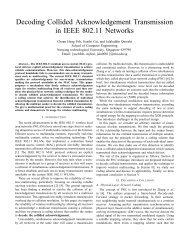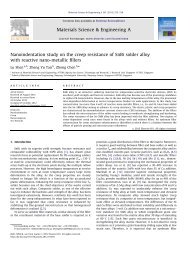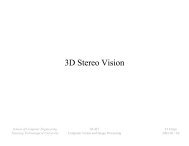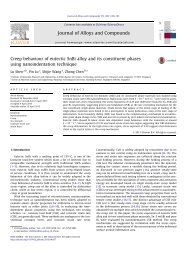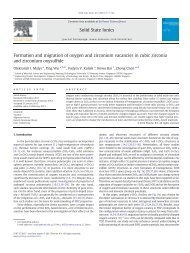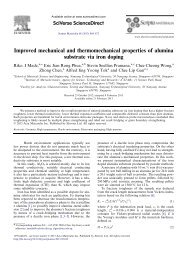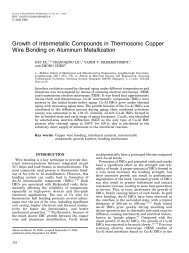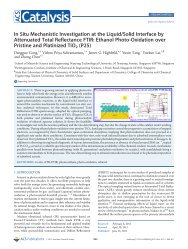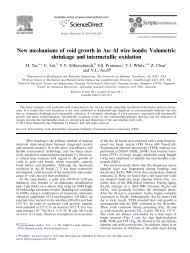Elasticity modulus, hardness and fracture toughness of Ni3Sn4 ...
Elasticity modulus, hardness and fracture toughness of Ni3Sn4 ...
Elasticity modulus, hardness and fracture toughness of Ni3Sn4 ...
Create successful ePaper yourself
Turn your PDF publications into a flip-book with our unique Google optimized e-Paper software.
110 Z. Chen et al. / Materials Science <strong>and</strong> Engineering A 423 (2006) 107–110<br />
The increase in <strong>toughness</strong> was, again, due to the densification <strong>of</strong><br />
the film by annealing. Densification reduces the number <strong>of</strong> flaws<br />
<strong>and</strong> the critical flaw size in the film, which improves the <strong>fracture</strong><br />
resistance. Besides the current work, there were only two<br />
reports on the <strong>fracture</strong> <strong>toughness</strong> <strong>of</strong> <strong>Ni3Sn4</strong> that were known<br />
to us, but both are measurements from bulk samples. Ghosh [4]<br />
reported the value to be 4.22 ± 0.45 MPa m 1/2 when the indentation<br />
load was 100 g <strong>and</strong> 3.65 ± 0.47 MPa m 1/2 when the load was<br />
200 g. The values should be compared, if a comparison needs<br />
to be made, with our result <strong>of</strong> 5.75 ± 0.25 MPa m 1/2 obtained<br />
from the 200 ◦ C specimens, because the treatment temperature<br />
is close to the annealing temperature <strong>of</strong> 222 ◦ C used in Ghosh’s<br />
work [4]. Our reported value is clearly higher. The microstructural<br />
difference could be responsible for such a difference. In<br />
our specimens, fine grain sized film <strong>fracture</strong>d by intergranular<br />
mode (Fig. 2). While in the case <strong>of</strong> Ghosh [4], the grain size<br />
was very large (32 m). Under both loads (100 <strong>and</strong> 200 g) the<br />
cracks induced by the indention were mainly contained inside<br />
an individual grain [4]. Both Ghosh’s work <strong>and</strong> our current<br />
work reported much higher values <strong>of</strong> <strong>fracture</strong> <strong>toughness</strong> than<br />
the one by Fields et al. [2], which was 1.2 ± 0.1 MPa m 1/2 . The<br />
specimens used in Fields et al.’s work were prepared by powder<br />
metallurgy. The <strong>fracture</strong> <strong>toughness</strong> <strong>of</strong> sintered specimens is<br />
highly dependent on the porosity; the lower value obtained in<br />
the work <strong>of</strong> Fields et al. [2] could be due to its relatively large<br />
pore size.<br />
4. Conclusion<br />
In this work, <strong>Ni3Sn4</strong> IMC thin films <strong>of</strong> 420 nm thick were<br />
prepared by co-sputtering <strong>and</strong> subsequent annealing. The <strong>hardness</strong><br />
<strong>and</strong> elasticity <strong>modulus</strong> measured by nano-indentation were<br />
7.0 <strong>and</strong> 134 GPa, respectively. Residual stress developed during<br />
annealing affected the measured <strong>hardness</strong> <strong>and</strong> elasticity <strong>modulus</strong>.<br />
Densification <strong>of</strong> the film during annealing significantly<br />
increased the <strong>fracture</strong> <strong>toughness</strong>. The <strong>fracture</strong> <strong>toughness</strong> <strong>of</strong> the<br />
<strong>Ni3Sn4</strong> thin film measured by controlled buckling test was,<br />
respectively, 2.11 ± 0.15, 4.08 ± 0.21 <strong>and</strong> 5.75 ± 0.25 MPa m 1/2<br />
for specimens annealed at 100, 150 <strong>and</strong> 200 ◦ C for 24 h.<br />
References<br />
[1] D.R. Frear, S.N. Burchett, H.S. Morgan, J.H. Lao (Eds.), The Mechanics<br />
<strong>of</strong> Solder Alloy Interconnects, Van Nostr<strong>and</strong> Reinhold, New York, 1994.<br />
[2] R.J. Fields, S.R. Low III, G.K. Lucey Jr., in: M.J. Cieslak, J.H.<br />
Perepezko, S. Kang, M.E. Glicksman (Eds.), The Metal Science <strong>of</strong> Joining,<br />
TMS, Warrendale, PA, 1992, pp. 165–173.<br />
[3] K. Nakajima, A. Isogai, Y. Taga, Jpn. J. Appl. Phys. Suppl. 2 (1974)<br />
309.<br />
[4] G. Ghosh, J. Mater. Res. 19 (2004) 1493.<br />
[5] J.S. Kang, R.A. Gagliano, G. Ghosh, M.E. Fine, J. Electron. Mater. 31<br />
(2002) 1238.<br />
[6] B. Subrahmanyan, Trans. Jpn. Inst. Met. 130 (1972) 93.<br />
[7] R.R. Chromik, R.P. Vinci, S.L. Allen, M.R. Notis, J. Mater. Res. 18<br />
(2003) 2251.<br />
[8] R. Cabarat, L. Guillet, R. LeRoux, J. Inst. Met. 75 (1975) 391.<br />
[9] L.M. Ostrovskaya, V.N. Rodin, A.I. Kuznetsov, Sov. J. Non-Ferrous Met.<br />
26 (1985) 90.<br />
[10] B. Balakrisnan, C.C. Chum, M. Li, Z. Chen, T. Cahyadi, J. Electron.<br />
Mater. 32 (2003) 166.<br />
[11] K.N. Tu, K. Zeng, Mater. Sci. Eng. R34 (2001) 1.<br />
[12] K. Zeng, K.N. Tu, Mater. Sci. Eng. R38 (2002) 55.<br />
[13] A.A. Liu, H.K. Kim, K.N. Tu, J. Appl. Phys. 80 (1996) 2774.<br />
[14] H.K. Kim, K.N. Tu, P.A. Totta, Appl. Phys. Lett. 68 (1996) 2204.<br />
[15] P.L. Liu, J.K. Shang, Metall. Mater. Trans. 31A (2000) 2867.<br />
[16] J.W. Jang, P.G. Kim, K.N. Tu, J. Appl. Phys. 85 (1999) 8456.<br />
[17] K.C. Hung, Y.C. Chan, C.W. Tang, H.C. Ong, J. Mater. Res. 15 (2000)<br />
2534.<br />
[18] P.L. Liu, J.K. Shang, J. Mater. Res. 15 (2000) 2347.<br />
[19] J.W. Jang, D.R. Peter, T.Y. Lee, K.N. Tu, J. Appl. Phys. 88 (2000) 6359.<br />
[20] M. He, Z. Chen, G. Qi, Acta Mater. 52 (2004) 2047.<br />
[21] Z. Chen, M. He, G. Qi, J. Electron. Mater. 33 (2004) 1465.<br />
[22] A. Kumar, M. He, Z. Chen, Surf. Coat. Technol. 198 (2005) 283.<br />
[23] M. He, Z. Chen, G.J. Qi, Metall. Mater. Trans. 36A (2005) 65.<br />
[24] B. Cotterell, Z. Chen, Int. J. Fract. 104 (2000) 169.<br />
[25] Z. Chen, B. Cotterell, W. Wang, E. Guenther, S.J. Chua, Thin Solid<br />
Films 394 (2001) 202.<br />
[26] Z. Chen, B. Cotterell, W. Wang, Eng. Fract. Mech. 69 (2002) 597.<br />
[27] Z. Chen, X. Xu, C.C. Wong, S. Mhaisalkar, Surf. Coat. Technol. 167<br />
(2003) 170.



